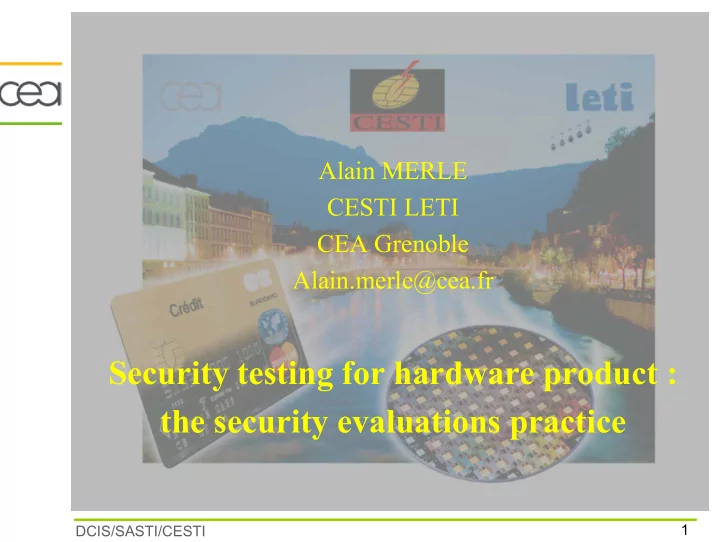

Alain MERLE CESTI LETI CEA Grenoble Alain.merle@cea.fr Security testing for hardware product : the security evaluations practice 1 DCIS/SASTI/CESTI
Abstract • « What are you doing in ITSEFs ? » – Testing, Security testing, Attacks, Evaluations, Common Criteria, Certification, … • Security evaluations: – The French Certification Scheme – The Common Criteria – Smartcards evaluations • Smartcard security testing – Strategy – Attacks 2 DCIS/SASTI/CESTI
Common Criteria The basic ideas • Describe what is the security of a product • Verify that the developer has done what it was supposed to do (and only that) • Test (functional and attacks) the product • Verify environmental constraints 3 DCIS/SASTI/CESTI
• A standardized, objective and efficient Security Analysis Method (ISO IS 15408) • An International Recognition through Mutual Recognition Arrangements. • In Europe, mostly used for smartcards – Integrated Circuits – IC with embedded software 4 DCIS/SASTI/CESTI
CESTI LETI Information Technology Security Evaluation Facilities Organisme • ITSEF of the French Certification Organisme de d’accréditation Certification : COFRAC D.C.S.S.I. Scheme Accréditation Agrément Certification • Area : hardware and embedded software Certificat CESTI – Smartcards Centre d’Evaluation de la Sécurité des Technologies de l’Information – Security equipments Le Schéma Français de Certification • Level: Up to EAL7 • Localization: Grenoble • Part of the biggest French Research center in Microelectronics 5 DCIS/SASTI/CESTI
Smartcard evaluation • Common Criteria, EAL4+ level – High Security level (banking applications) – White box evaluation • Design information • Source code • A table defining the « attack potential » – Time, expertise, equipment, knowledge, … – The card must resist to the « maximum » (ie all realistic attacks) 6 DCIS/SASTI/CESTI
What kind of testing ? • Functional testing but security oriented – Are the Security Functions working as specified ? • Attacks – Independent vulnerability analysis – Higher levels (VLA.4): adaptation of the classical “attack methods” to the specificities of the product 7 DCIS/SASTI/CESTI
Test strategy (Attacks) State of the art R&D Attacks Attacks Attacks Tests and and Potential and Potential Potential vulnerabilities Vulnerabilities Vulnerabilities Strategies Add Add Add Remove Remove Remove Customize Customize Customize Evaluation tasks 8 DCIS/SASTI/CESTI
Attacks on smartcards • Physical (Silicon related) – Memories – Access to internal signals (probing) • Observation: Side Channel Analysis – SPA, EMA, DPA, DEMA • Perturbations: inducing errors – Cryptography (DFA) – Generating errors • IO errors (reading, writing) • Program disruption (jump, skip, change instruction) • Specifications/implementation related attacks – Protocol, overflows, errors in programming, … 9 DCIS/SASTI/CESTI
Optical reading of ROM Probing : MEB Reverse Engineering Probing : laser preparation 10 DCIS/SASTI/CESTI
Modification : FIB Modification : Laser cut 11 DCIS/SASTI/CESTI
EM signal analysis 12 DCIS/SASTI/CESTI
SPA/EMA Analysis DES AES 13 DCIS/SASTI/CESTI
SPA/DPA analysis 14 DCIS/SASTI/CESTI
Cartography Electro-magnetic signal during DES execution. •Hardware DES •Differential signal 15 DCIS/SASTI/CESTI
Cartography 16 DCIS/SASTI/CESTI
Perturbations examples Branch on error Non critical processing; Initializations If not authorized then goto xxx; Critical processing; valid = TRUE; Re-reading after integrity checking If got ^= expected then valid = FALSE ; Memory integrity checking ; If valid Then Non critical processing; critical processing; Data 1 reading; Critical processing; Data 2 reading; Critical processing; 17 DCIS/SASTI/CESTI
What is requested from a lab ? • Good knowledge of the state of the art – Not always published • Internal R&D on attacks – Equipment – Competences • Multi-competences – Cryptography, microelectronics, signal processing, lasers, etc • Competence areas defined in the French Scheme – Hardware (IC, IC with embedded software) – Software (Networks, OS, …) 18 DCIS/SASTI/CESTI
Test benches 19 DCIS/SASTI/CESTI
Competences Software Microelectronic Testbenches 20 DCIS/SASTI/CESTI
Some rules • Security is the whole product : IC + software • The IC must hide itself – Critical processing,Sensitive data handling,Consistency checking, Memory access, … • The IC must control itself – Consistency checking,Audits, log, … • But some attacks are now dedicated to these counter-measures 21 DCIS/SASTI/CESTI
CONCLUSION (1) • Evaluation is – Rigorous & normalized process – But attacks require specific « human » skills • Attack is – Gaining access to secret/forbidden operations – Free to « play » with the abnormal conditions – An error is not an attack • But an error can often be used in attacks 22 DCIS/SASTI/CESTI
CONCLUSION (2) • The evaluation guarantees that – The product is working as specified – It has a “good” resistance level • Perfection as absolute security does not exist 23 DCIS/SASTI/CESTI
Recommend
More recommend